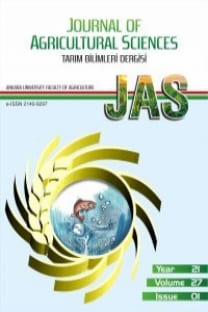Determining Alternative Crops with Multi Criteria Decision Making Methods within the Framework of Land Risk Criteria
Determining Alternative Crops with Multi Criteria Decision Making Methods within the Framework of Land Risk Criteria
Risk criteria, Alternative crops, AHP, ELECTRE TOPSIS,
___
- Akçaöz H V & Özkan B. 2002. Tarımsal üretimde karşılaşılan riskler ve uygulanabilecek stratejiler. Türkiye V. Tarım Ekonomisi Kongresi, Erzurum.
- Alper D & Başdar C. 2017. A comparison of TOPSIS and ELECTRE methods: an application on the factoring industry. Business and Economics Research Journal 8(3): 627.
- Benayoun R, Roy B & Sussman B. 1966. ELECTRE: Une méthode pour guider le choix en présence de points de vue multiples. Note de travail 49: 2-120.
- Hwang C L & Yoon K. 1981. Methods for multiple attribute decision making. Multiple attribute decision making, Springer: 58-191.
- Karaca E. 2013. ELECTRE I ve TOPSIS yöntemlerini kullanarak bir otomotiv firması için bayi seçimi, Kocaeli Universitesi, Fen Bilimleri Enstitusu.
- Myers J H & Alpert M I. 1968. Determinant buying attitudes: meaning and measurement. Journal of Marketing 32(4_part_1): 13-20.
- Ömürbek N, Karaatli M & Cömert H G. 2016. AHP-SAW ve AHP-ELECTRE yöntemleri ile yapı denetim firmalarının değerlendirmesi. Yönetim Bilimleri Dergisi 14(27): 171-199.
- Rani A, Bandyopadhyay K, Krishnan P, Sarangi A & Datta S. 2020. Simulation of tillage, crop residue mulch and nitrogen interactions on yield and water use efficiency of wheat (Triticum aestivum) using DSSAT model. Indian Journal of Agricultural Sciences 90(10): 20-28.
- Saaty T L. 1977. A scaling method for priorities in hierarchical structures. Journal of mathematical psychology 15(3): 234-281.
- Sánchez-Lozano J, García-Cascales M S & Lamata M T. 2016. Comparative TOPSIS-ELECTRE TRI methods for optimal sites for photovoltaic solar farms. Case study in Spain. Journal of cleaner production 127: 387-398.
- Seyedmohammadi J, Sarmadian F, Jafarzadeh A A, Ghorbani M A & Shahbazi F. 2018. Application of SAW, TOPSIS and fuzzy TOPSIS models in cultivation priority planning for maize, rapeseed and soybean crops. Geoderma 310: 178-190.
- Triantaphyllou E. 2000. Multi-criteria decision making methods. Multi-criteria decision making methods: A comparative study, Springer: 5-21.
- Tunca M, Aksoy E, Bülbül H & Ömürbek N. 2015. Ahp Temelli Topsıs Ve Electre Yöntemiyle Muhasebe Paket Use Of Ahp-Based TOPSIS and ELECTRE Methods on Accounting Software Selection. Niğde Üniversitesi İktisadi ve İdari Bilimler Fakültesi Dergisi 8(1): 53-71.
- Tümer E İ, Birinci A & Aksoy A. 2010. Tarımsal üretimi etkileyen risk faktörleri ve stratejilerinin belirlenmesi: Erzurum İli Örneği. Türkiye IX. Tarım Ekonomisi Kongresi: 22-24.
- Yalçiner D & Karaatli M. 2018. Mevduat bankasi seçimi sürecinde TOPSIS ve ELECTRE yöntemlerinin kullanılması. Süleyman Demirel Üniversitesi İktisadi ve İdari Bilimler Fakültesi Dergisi 23(2): 401-423.
- Yayın Aralığı: 4
- Yayıncı: Ankara Üniversitesi Basımevi
Recent Advances in High Pressure Processing of Milk and Milk Products - A review
Sofia AGRİOPOULOU, Merve SEVEROĞLU, Theo VARZAKAS, Hamdi Barbaros ÖZER
Isolation and Characterization of Rhizospheric Bacteria from Vuralia turcica Rhizospheric Soil
Cem ÇİFTÇİ, Dilek TEKDAL, Burçin ÇINGAY, Selim ÇETİNER
Kübra ÖZKAN, Ayşe KARADAĞ, Osman SAĞDIÇ
Osman Tolga ÖZEL, Recayi ÇİMAGİL, Selin ERTÜRK GÜRKAN, İsa COŞKUN, Mustafa TÜRE, İlyas KUTLU
The Combined Effects of Salinity and Drought on Young Almond Trees and Physiological Parameters
Cenk KÜÇÜKYUMUK, Donald SUAREZ
Do Agricultural Supports Affect Production? A Panel ARDL Analysis of Turkey
Moustapha Maman MOUNIROU, Emre Can KAYA, Mehmet Burak TAŞKIN, Ali İNAL, Hamidou Taffa ABDOUL-AZİZE
IsVoNet8: A Proposed Deep Learning Model for Classification of Some Fish Species
Volkan KAYA, İsmail AKGÜL, Özge ZENCİR TANIR
Modelling Yield Response and Water Use to Salinity and Water Relations of Six Pepper Varieties
Gülüzar Duygu SEMİZ, Cansu ŞENTÜRK, Ahmet Cengiz YILDIRIM, Elifnaz TORUN
